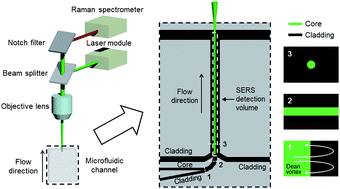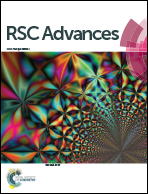Integrated real-time optofluidic SERS via a liquid-core/liquid-cladding waveguide
Abstract
This paper describes the realization of highly sensitive surface-enhanced Raman spectroscopy (SERS) via an integrated three-dimensional liquid-core/liquid-cladding waveguide. The cladding flow enclosed the core flow in both the horizontal and vertical directions within a single-layered microfluidic channel, and the laser beam was guided through the core stream. Deionized water was used to suspend SERS-active silver nanocolloids to form the core fluid, and 2,2,2-trifluoroethanol was used as the cladding fluid. Dipicolinic acid, commonly used as a biomarker for the detection of Bacillus anthracis, was employed as the target analyte. The sensitivity of the SERS signal was enhanced through this design because the signals backscattered from the analytes accumulated along the core stream and increased the SERS detection volume. The SERS data was evaluated in terms of the analyte concentration in the core fluid, the irradiated laser power, and the cross-sectional area of the core stream. The present data were compared with a conventional SERS detection approach in order to quantify the enhancement factor. The detection limit of concentration, 50 nM at an acquisition time of 6 s, was a factor of 35 smaller than that of conventional methods.


 Please wait while we load your content...
Please wait while we load your content...